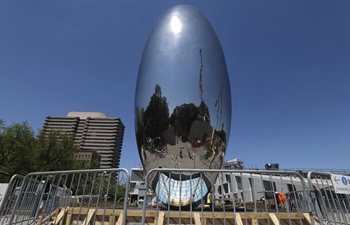WASHINGTON, April 11 (Xinhua) -- An international team led by Chinese scientists has revealed the wing color of a 200-million-year-old insect via fossil scales.
The study, published on Wednesday in the journal Science Advances, found that tiny photonic structures of lepidopterans could produce metallic bronze to golden color appearances in the insect wings.
Structural colors in a myriad of animals and plants result from the wavelength-selective scattering of incident light which are typically more vibrant and visually arresting than those produced via pigmentation and are often multifunctional, playing important roles in intraspecific sexual signaling, aposematism and crypsis.
Researchers scaled architectures from Jurassic Lepidoptera from the United Kingdom, Germany, Kazakhstan and China, and Tarachoptera from mid-Cretaceous Burmese amber.
Using the ultrastructural parameters identified in Jurassic specimens, they demonstrated the use of optical modeling to describe the theoretical optical properties of the type-1 bilayer scale arrangement, thus providing the earliest evidence of structural colors in the insect fossil record.
The Jurassic lepidopterans exhibit a type-1 bilayer scale vestiture: an upper layer of large fused cover scales and a lower layer of small fused ground scales.
This scale arrangement, plus preserved herringbone ornamentation on the cover scale surface, is almost identical to those of some extant Micropterigidae.
Also, the fossil scale ultrastructures possess periodicities measuring from 140 to 2,000 nanometers and are therefore capable of scattering visible light, according to researchers.
Wang Bo, a researcher from Nanjing Institute of Geology and Paleontology of the Chinese Academy of Sciences told Xinhua that this was the earliest known structural color of insects, pushing the record backward at least for 130 million years.
"It has demonstrated that nanometer-level optical structures can be preserved in Mesozoic amber, opening a window for restoring the structural colors of ancient animals and plants."













